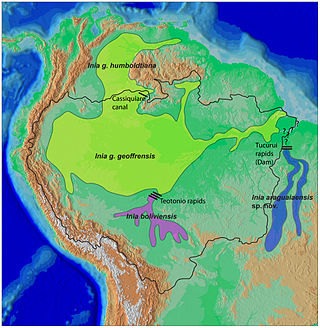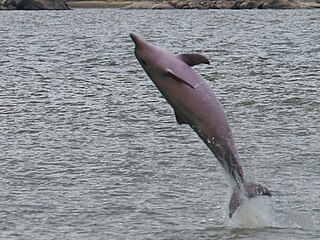
The Amazon river dolphin, also known as the boto, bufeo or pink river dolphin, is a species of toothed whale which is native to and is exclusively of South America classified in the family Iniidae. Three subspecies are currently recognized: I. g. geoffrensis, I. g. boliviensis and I. g. humboldtiana while position of Araguaian river dolphin within the clade is still unclear. The three subspecies are distributed in the Amazon basin, the upper Madeira River in Bolivia, and the Orinoco basin, respectively.

River dolphins are a polyphyletic group of fully aquatic mammals that reside exclusively in freshwater or brackish water. They are an informal grouping of dolphins, which itself is a paraphyletic group within the infraorder Cetacea. Extant river dolphins are placed in two superfamilies, Platanistoidea and Inioidea. They comprise the families Platanistidae, the recently extinct Lipotidae, Iniidae and Pontoporiidae. There are five extant species of river dolphins. River dolphins, alongside other cetaceans, belong to the clade Artiodactyla, with even-toed ungulates, and their closest living relatives the hippopotamuses, from which they diverged about 40 million years ago. Specific types of Dolphins can be pink.

Oceanic dolphins or Delphinidae are a widely distributed family of dolphins that live in the sea. Close to forty extant species are recognised. They include several big species whose common names contain "whale" rather than "dolphin", such as the Globicephalinae. Delphinidae is a family within the superfamily Delphinoidea, which also includes the porpoises (Phocoenidae) and the Monodontidae. River dolphins are relatives of the Delphinoidea.

The tucuxi, alternatively known in Peru bufeo gris or bufeo negro, is a species of freshwater dolphin found in the rivers of the Amazon basin. The word tucuxi is derived from the Tupi language word tuchuchi-ana, and has now been adopted as the species' common name. Despite being found in geographic locations similar to those of 'true' river dolphins such as the boto, the tucuxi is not closely related to them genetically. Instead, it is classed in the oceanic dolphin family (Delphinidae).

Lagenorhynchus is a genus of oceanic dolphins in the infraorder Cetacea, presently containing six extant species. However, there is consistent molecular evidence that the genus is polyphyletic and several of the species are likely to be moved to other genera. In addition, the extinct species Lagenorhynchus harmatuki is also classified in this genus.

The Pacific white-sided dolphin, also known as the hookfin porpoise, is an active dolphin found in the cool or temperate waters of the North Pacific Ocean.

Anhatomirim Environmental Protection Area is a protected area to the north of Florianópolis on the coast of Santa Catarina, Brazil.

Boto is a Portuguese name given to several types of dolphins and river dolphins native to the Amazon and the Orinoco River tributaries. A few botos exist exclusively in fresh water, and these are often considered primitive dolphins.
Sagmatias was a genus of dolphins, defined in 1866 by Edward Drinker Cope with Peale's dolphin as type species, described as Sagmatias amblodon. It has been proposed to resurrect the genus to include four species of oceanic dolphins currently classified in the genus Lagenorhynchus. Mitochondrial DNA studies have indicated that Pacific white-sided dolphin, Peale's dolphin, dusky dolphin and hourglass dolphin are more closely related to dolphins in the Lissodelphininae subfamily, than to the two other members of the genus: Atlantic white-sided dolphin and white-beaked dolphin. This phylogenetic relationship is further supported by cladistic analysis of morphological characters. However, resurrection of the genus Sagmatias has not been accepted by the Society for Marine Mammalogy's taxonomic Committee, because the finer details of the phylogenetic relationships between the four species in the proposed Sagmatias genus and the four species of dolphins in the genus Cephalorhynchus remains to be resolved. Genetic and bioacoustical evidence suggest that Peale's dolphin and hourglass dolphin are closer related to the Cephalorhynchus species than to the Pacific white-sided dolphin and dusky dolphin, which, if true, would make the genus Sagmatias paraphyletic.
Pellona harroweri, called the American coastal pellona and the caille, is a species of longfin herring native to the beaches and estuaries of the western Atlantic from Panama to southern Brazil. Some individuals can reach 18 cm, with the average closer to 12 cm. They school in very shallow waters, and are rarely found deeper than 16 m.

The Guiana dolphin, also known as the estuarine dolphin or costero, is a dolphin found in the coastal waters to the north and east of South America, and east of Central America. It is a member of the oceanic dolphin family (Delphinidae). It can live in both saltwater and freshwater.

The Purus várzea (NT0156) is an ecoregion of seasonally flooded várzea forest in the central Amazon basin. It is part of the Amazon biome. The ecoregion is home to a vegetation adapted to floods of up to 12 metres (39 ft) that may last for eight months. There is a great variety of fish and birds, but relatively fewer mammals. Ground-dwelling mammals must migrate to higher ground during the flood season. Threats include logging, cattle farming, over-fishing and mercury pollution from gold mining.

The Xingu–Tocantins–Araguaia moist forests (NT0180) is an ecoregion in the eastern Amazon basin. It is part of the Amazon biome. The ecoregion is one of the most severely degraded of the Amazon region, suffering from large-scale deforestation and selective extraction of timber, particularly along the Trans-Amazonian Highway and in the higher and more populated southern portions.
Cetaceans form an infra-order of marine mammals. In 2020, approximately 86 species of cetaceans had been identified worldwide. Among these species, at least 35 have been sighted in the wider Caribbean region with very widespread distribution and density variations between areas. Caribbean waters are a preferred breeding site for several species of mysticeti, who live further north the rest of the year. The tucuxi and the boto live at the southern periphery of the Caribbean region in the freshwaters of the Amazon river and surrounding drainage basins.













